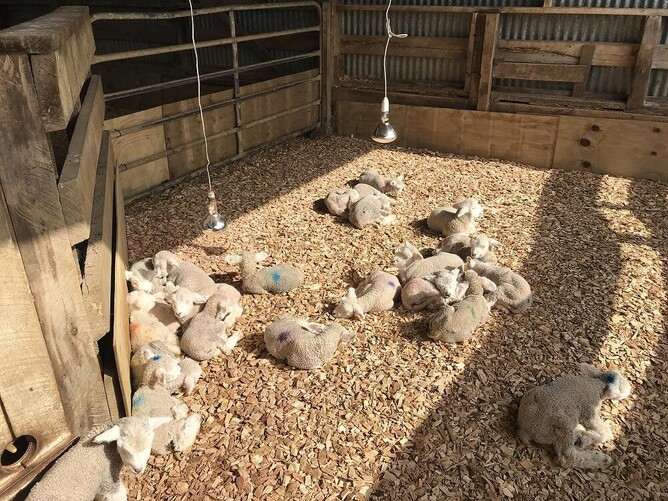A comprehensive guide to setting up a successful lamb rearing shed.
Lambing is always hectic and once the season starts you won’t have the time to keep dashing out for essentials. If you are going to be rearing lambs this year, it pays to have your lamb shed well prepared ahead of time!
Here’s a guide to setting up a suitable lamb shed, with everything you may need to keep any lambs you bring in as healthy as possible from day one.
Facilities - how to set up the shed:
Hay and implement sheds are the preferred location for rearing lambs, as these are unlikely to have been previously used by adult sheep.
Avoid rearing lambs in sheep yards and woolsheds as these areas are a great source of disease for young lambs with a naïve immune system.
Warm, clean, dry and draught-free sheds, with good ventilation to reduce ammonia build up are essential. Ensure you check this at the lamb’s level.
Warming pens with heat lamps should be provided to warm young or cold lambs. These should be easy to clean to reduce the spread of disease.
The floor should be sloped to avoid any pooling of water.
Pen divisions should be solid, to reduce draughts and the spread of disease. Straw bales or windbreak cloth can be used, however something that can be easily cleaned, such as aluminum, steel or plastic is preferred.
Pens should have a minimum 0.5-0.6m2 allocated per lamb to avoid overcrowding. A study from AgResearch found that 0.9m2 per lamb in the first three weeks of rearing is associated with improved growth and health compared to 0.5m2. Small group sizes (10-12 lambs) are recommended in the first 2-3 weeks of life.
Woodchips or shavings are the preferred bedding types, being warm and dust free. Straw can become dirty quickly, and sawdust can be too dusty. Bedding needs to be completely replaced each season or between groups of lambs.
Ensure the pens are free from sharp objects or edges the lambs could hurt themselves on.
Food and water - getting the essentials right:
Unrestricted access to fresh, clean water in all pens is required. Troughs should be well secured, and at a height where the smallest lambs can reach the water, but are not able to climb in and drown.
Ad-lib access to hay and a good quality, palatable meal should be provided from day one to aid rumen development. Most meals will have a coccidiostat added.
Plastic or wooden meal troughs can be placed at ground level or just off the ground. There must be enough room for all the lambs to have access post-weaning, with a minimum of 30cm per head required.
Have plenty of colostrum on hand (mother's milk, commercial colostrum powders, or cow colostrum) for the lamb's first feed. It is safest to assume that all lambs coming into the shed have not received any colostrum.
Use whey-based or whole milk lamb milk replacer powders designed for lamb growth and early weaning. Not all milk replacer powders have a coccidiostat included, so this may need to be added separately.
Sodium bentonite is a special clay that can be added to meal. This clay acts as a buffer against rumen acidosis, absorbs toxins, and reduces scours.
Miscellaneous - all the animal health supplies you'll need to help your lambs to thrive:
Tags with imprinted numbers. Every lamb should be tagged as it enters the shed. Avoid writing on each tag; as lambs get older they like to suck on tags, which could remove the number.
Scales. Every lamb should be regularly weighed to ensure they are growing well.
Supplies for a dextrose injection: Dextrose 40% mixed with sterile water to form a 20% solution, sterile needles and syringe.
Stomach tube.
Iodine spray. Every lamb coming into the shed and moving between pens should have its navel sprayed.
Broad spectrum disinfectant. Sheds should be disinfected prior to the start of lambing, and then weekly. Feeders and troughs should also be regularly disinfected.
Vaccinations for clostridial disease and scabby mouth. Some vaccinations can be safely given to lambs from day one, and should be given to those coming into the lamb shed to reduce the spread of disease.
Woollen or plastic jackets to help keep lambs warm.
Stalosan or a similar powder that absorbs moisture and binds ammonia in the bedding, to help control bacteria, viruses, fungi, parasites and fly larvae.
Anti-inflammatories/pain relief: any time an antibiotic is being used in your ewes or lambs, an anti-inflammatory should be used too. Effective pain relief gets ewes and lambs up and eating/drinking more quickly.
Separate clothing and footwear for sick and healthy pens.
A clean place to put the lambs when they are being transported from the paddocks to the shed.
Give us a call if you need any more animal health advice around lamb rearing and keep an eye out for our digital Spring Order form, where you'll be able to order your essentials and get some great deals.
We hope you have a successful lambing!

